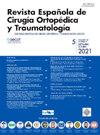软骨发育不全儿童可重复使用套筒股髓内钉的生物力学评价与分析。
Q3 Medicine
Revista Espanola de Cirugia Ortopedica y Traumatologia
Pub Date : 2025-03-27
DOI:10.1016/j.recot.2025.03.005
引用次数: 0
摘要
简介:伸缩式髓内钉(CIMT)在肢体延长手术中取得了重大进展。然而,在软骨发育不全患者的骨骼中,它们的延伸能力被限制在5厘米。因此,已经开发了涉及CIMT再利用的技术。由于材料疲劳和重复载荷,这种重复使用带来了机械和安全方面的挑战,这可能会损害植入物的结构完整性。本研究评估了重复使用CIMT的生物力学性能和潜在损伤。方法:对软骨发育不全患者进行两次5cm延长手术后切除的TIMN进行实验分析。通过非破坏性解构、材料分析、逆向工程三维建模和有限元分析(FEM)对钉子进行测量和评估,以评估其在不同载荷条件下的性能。结果:确定了机械和化学损伤,损害了指甲的完整性。对时效Ti6Al4V合金的抗复杂载荷性能进行了验证。三维建模表明,齿轮机构有效地将旋转运动转化为平移运动。有限元分析结果表明,安全系数在2.44°和2.25°角处达到临界极限,表明钉已接近其阻力极限。阀杆和导向被确定为关键部件。结论:由于潜在的材料疲劳,CIMT的再利用必须谨慎进行。该研究为重新设计这些植入物提供了基础,以提高其承受长时间加载循环的能力。证据等级:四级,临床前实验研究。本文章由计算机程序翻译,如有差异,请以英文原文为准。
Evaluación biomecánica y análisis de clavo intramedular telescópico de fémur reutilizado en niño con acondroplasia
Introduction
Telescopic intramedullary nails (TIMN) have represented a significant advancement in limb lengthening procedures. However, their elongation capacity is limited to 5 cm in the bones of patients with achondroplasia. Consequently, techniques involving TIMN reutilization have been developed. This reuse presents mechanical and safety challenges due to material fatigue and repetitive loading, which may compromise the structural integrity of the implant. This study evaluates the biomechanical performance and potential damage of a reused TIMN.
Methods
An experimental analysis was conducted on a TIMN removed after 2 5 cm lengthening procedures in a patient with achondroplasia. The nail was measured and assessed following non-destructive deconstruction, material analysis, 3 D modeling through reverse engineering, and finite element analysis to assess its behavior under different loading conditions.
Results
Mechanical and chemical damage was identified, compromising the nail's integrity. The aged Ti6Al4V alloy was validated for its resistance to complex loads. The 3 D modeling showed that the gear mechanism effectively converted rotational movement into translational motion. The finite element analysis revealed that the safety factor reached its critical limit at angles of 2.44 and 2.25°, showing that the nail was nearing its resistance limit. The stem and guide were identified as critical components.
Conclusions
TIMN reutilization must be performed with caution due to potential material fatigue. This study provides a foundation for redesigning these implants to improve their capacity to withstand prolonged loading cycles.
求助全文
通过发布文献求助,成功后即可免费获取论文全文。
去求助
来源期刊

Revista Espanola de Cirugia Ortopedica y Traumatologia
Medicine-Surgery
CiteScore
1.10
自引率
0.00%
发文量
156
审稿时长
51 weeks
期刊介绍:
Es una magnífica revista para acceder a los mejores artículos de investigación en la especialidad y los casos clínicos de mayor interés. Además, es la Publicación Oficial de la Sociedad, y está incluida en prestigiosos índices de referencia en medicina.
 求助内容:
求助内容: 应助结果提醒方式:
应助结果提醒方式:


